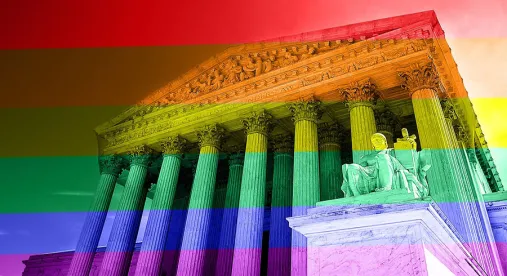A few weeks ago, we told you the story of Hannah and Bob, and the U.S. Supreme Court’s landmark holding that under Title VII of the Civil Rights Act of 1964, it is impossible to discriminate against a person for being gay, lesbian, or transgender without discriminating against that person based on sex.
As we wrote in our article at the time:
When a gay or lesbian person such as Hannah or Bob is fired for loving a person of the same sex, or for presenting at work as the opposite sex into which they were born, then Hannah or Bob is being treated differently due to sex. Given the way Title VII is drafted and the plain meaning of the terms used in the statute, the Court held that there is no way around this conclusion.
The ruling is significant for lesbian, gay, bisexual, transgender, and queer (LGBTQ) American workers, indeed. But the implications of the Court’s Bostock decision, and its interpretation of sex as a protected category, extends far beyond Title VII’s employment hiring and firing protections that are now afforded to workers like Hannah and Bob. This post explores some of those implications, and how businesses across the country should start thinking about re-examining policies, practices and procedures to ensure compliance with the law and respect for individual workers’ expressions in the workplace. We address some of those issues below.
A. Grooming Standards
Is this Supreme Court ruling the death knell for employer grooming standards that differentiate between men and women? The Supreme Court directly said in its opinion that it was not addressing grooming standards. To date, even the EEOC has allowed employers to have distinct grooming policies for men and women, and many courts have agreed. These policies and cases have noted that as long as “equivalent” grooming policies exist for men and women, employers can draft them differently depending on gender.
However, Bostock was a reminder to employers that “sex stereotyping” theories of discrimination have long been recognized by the Supreme Court. Grooming standards that are different for men and women (such as only women can wear earrings) are quite arguably based on gender stereotypes. It is now time to review your grooming policy. Is it generic and gender-free – such as requiring employees to dress “professionally” without specifying which sex can wear what? If so, then it is likely to withstand challenge compared to a policy that lists articles of clothing only one gender can wear.
B. Applications and Personnel Records
Personnel records often reflect (and sometimes legally require) employees’ gender. But even before an employee is hired, many application forms ask applicants to check a box indicating whether they are male or female. The signal such a binary designation sends to applicants may dissuade qualified workers from seeking a position. The same is true with respect to personnel forms that only ask for binary gender designations. Without providing a “third” non-binary option or allowing the applicant or employee to write in their own gender identity on any forms, employers may be causing discomfort or, worse, engaging in disparate impact discrimination by excluding gender non-conforming or transitioning individuals from participation in certain terms and conditions of employment.
But a fairly simple fix is achievable: include a third option on forms for “non-binary.” This allows employees to be expressive in their identity from the commencement of employment, and signals to applicants that your business is an affirming place to work. As we discussed last year, in some cases, this data collection may result in underreporting on EEO-1 forms (at least until the federal government allows for third gender reporting options). However, the EEOC previously advised that employers “may report employee counts and labor hours for non-binary gender employees by job category and pay band and racial group in the comment box on the Certification Page.” While not a perfect solution, it gives employers some flexibility in their reporting obligations. Notwithstanding the limited guidance from the EEOC on how employers should be collecting gender non-binary data, such data collection will help employers comply with employee benefits requirements as discussed in Section E below; and the positive impact that adding a third option on employment forms may have on employee morale is important to achieving a welcoming, diverse and equitable workplace.
C. Bathrooms and Locker Rooms
As with grooming standards, the Supreme Court specifically said in its Bostock ruling that it was not addressing the issue of whether employers can maintain separate bathrooms and locker rooms for employees. That said, one particularly practical piece of advice for employers in this area has to do with transgender employees. To start, it is important to understand that transgender is an umbrella term that includes both gender identity and gender expression. Gender identity is each person’s internal and individual experience of gender and is a person’s sense of being a woman, a man, both, neither, or anywhere along the gender spectrum. Gender expression is how a person publicly expresses or presents their gender, which can include behavior and outward appearance such as dress, hair, makeup, body language and voice.
Back to the gender stereotyping theory that the Supreme Court recognizes under Title VII, an employer that prevents a person who was born a man, but who presents as a woman in dress, hair, and makeup, from using the women’s restroom at work may be violating the law. We recommend employers come up now with policies and guidelines for transgender employees because it is a complex area for which you should be prepared.
D. ADA/FMLA Considerations
Traditional disability accommodation and protected leave rights are also implicated by the Bostock decision and, in some cases, may give rise to a “sex-plus” type of claim, as one federal appeals court recently found. Specifically, individuals who are transitioning or who are seeking medical or mental health treatment in connection with a gender transition or their sexual orientation may have reasonable accommodation needs under the Americans with Disabilities Act (ADA), or a right to protected leave under the Family and Medical Leave Act (FMLA). Gender-affirming surgery and hormone treatments may require time away from the workplace or other reasonable accommodations that allow the transitioning employee to perform their essential job duties. But even if an employer argues that the transition and treatments sought do not meet the ADA’s definition of a disability, declining accommodations for a transitioning employee who is seeking medical or mental health treatment on account of their transition, after Bostock, may constitute unlawful discrimination on account of their sex.
Employers should ensure their leave request and reasonable accommodation policies account for these matters, and leave/accommodation administration personnel should be trained on these subjects to avoid exposure to ADA, FMLA or sex-plus type claims.
E. Employee Benefits
Title VII protects workers from more than just discriminatory hiring and firing decisions. As our Foley employee benefits colleagues recently discussed, it protects employees from discrimination in the terms and conditions of employment, including employer-sponsored benefit plans, too. Specifically, health plans that categorically exclude gender affirmation surgeries, hormone therapy, or mental health counseling for individuals who are transitioning may be discriminatory post-Bostock, if similar services are available to non-transgender employees. Other plans may exclude same-sex spouses and spouses’ children from dependent eligibility. Moreover, many benefit plan enrollment forms only contain binary gender markers – male or female – which do not account for non-binary individuals. In states like California, government-issued documents must legally provide residents with a “non-binary” option, which could complicate benefit enrollment for plans without a third gender option. Employers should take time to review their benefit plans in light of Bostock and determine whether these or other discrimination issues exist.
F. A Look Forward – Religious Freedoms and the Religious Freedom Restoration Act
While Bostock gave greater rights to LGBTQ workers, it left open the door to how protections for sincerely held religious beliefs might limit Title VII’s protections. Religious institutions already have statutory and constitutional exemptions to Title VII’s purview in connection with employment of “ministers” who convey the institution’s message and carry out its mission as a function of their job. Moreover, the Religious Freedom Restoration Act (RFRA) prohibits the federal government from burdening an individual’s free exercise of religion, unless doing so is the least restrictive means of furthering the government’s interest. While the Supreme Court has not yet opined whether enforcement of Title VII’s protections burdens a religious employer in violation of the RFRA, we are sure to see litigation around this question. To date, only the Sixth Circuit Court of Appeals has reviewed the push-and-pull of Title VII’s protections for LGBTQ workers against the rights afforded employers under the RFRA, finding enforcement of Title VII was not overly burdensome.
Questions around the RFRA’s application to Title VII will continue until the issue is more squarely addressed by the Supreme Court or some legislative reconciliation occurs.
G. Stay Tuned for More and Prepare Now
Bostock has opened up a whole new frontier in labor and employment law. Start thinking right away about how your employment policies and practices impact employees based on sex. If you are like most employers, you will need to revise many such policies. Act now to avoid claims.





 />i
/>i

